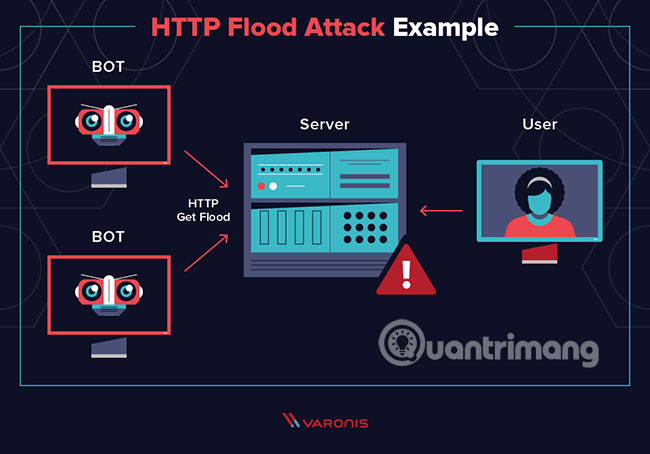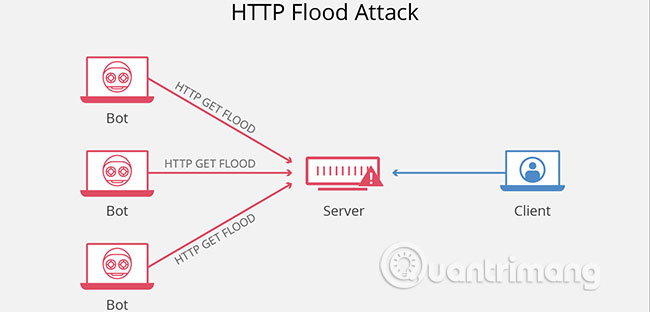What is HTTP Flood?
What is an HTTP flood attack?
HTTP floods are a type of Distributed Denial of Service (DDoS) attack, in which an attacker exploits seemingly legitimate HTTP GET or POST requests to attack a web server or application.
HTTP flood attacks are attacks that often use a botnet zombie army, a group of computers connected to the Internet, each computer has been taken over, usually with the help of malware. like Trojan Horse.
As a sophisticated Layer 7 attack, HTTP floods do not use oddly formatted packets, spoofing or reflection techniques (require third-party mapping), and require less bandwidth than those that are known to be malicious. Another attack, to 'depose' the targeted website or server.
Therefore, they require a deeper understanding of the targeted website or application and each attack must be specifically designed to be effective. This makes HTTP flood attacks much harder to detect and prevent.

Describe the HTTP flood attack
When an HTTP client like the web browser 'communicates' with the application or server, it sends an HTTP request - usually one of two types of requests: GET or POST. The GET request is used to retrieve static, standard content such as images, while the POST request is used to access dynamically generated resources.
An attack is most effective when it forces the server or application to allocate maximum resources possible to meet each request. Therefore, hackers will generally aim to flood the server or application with lots of requests, the more each request uses the resources it can handle.
For this reason, HTTP flood attacks that use POST requests tend to be the most 'resource efficient' in the attacker's perspective; because POST requests may include complex server-side trigger triggers. On the other hand, HTTP GET-based attacks can be created more easily and effectively in botnet scenarios.
Methods to minimize HTTP flood attacks

HTTP flood attacks are difficult to distinguish from valid traffic, because they use standard URL requests. This makes them one of the most advanced security challenges currently facing servers and applications. Traditional scale-based detection is ineffective in finding HTTP flood attacks, because the traffic in HTTP floods is often below the detection threshold.
The most effective mitigation mechanism is based on a combination of various methods of shaping traffic, including IP identification, abnormal activity tracking, and the use of advanced security methods (e.g., JavaScript parsing bridge).
You should read it
May be interested
- How HTTP works
 hypertext transfer protocol (http) provides a network protocol standard that web browsers and servers use to communicate. you see http every day because when you visit a website, the protocol is written right in the url.
hypertext transfer protocol (http) provides a network protocol standard that web browsers and servers use to communicate. you see http every day because when you visit a website, the protocol is written right in the url. - Response (Response) in HTTP
 after receiving and interpreting a request message, a server sends a response signal with an http response message.
after receiving and interpreting a request message, a server sends a response signal with an http response message. - 5 ways to improve website speed with HTTP / 2
 hypertext transfer protocol version 2 (hypertext transfer protocol version 2) or http / 2 is the latest http standard. updates to this protocol will improve the speed, performance and security of web traffic.
hypertext transfer protocol version 2 (hypertext transfer protocol version 2) or http / 2 is the latest http standard. updates to this protocol will improve the speed, performance and security of web traffic. - AI uses tweets to help researchers analyze the flood situation
 scientists at the joint research center - a european center for knowledge and science, describe in detail how real-time reporting information is posted by users on platforms. social media (especially twitter) can be helpful for the european flood warning system (efas).
scientists at the joint research center - a european center for knowledge and science, describe in detail how real-time reporting information is posted by users on platforms. social media (especially twitter) can be helpful for the european flood warning system (efas). - Encrypt status in HTTP
 the status-code element is a 3-character integer, in which the first character of the status encoding defines the response type and the last two characters do not have any sorting role. there are 5 values of the first character.
the status-code element is a 3-character integer, in which the first character of the status encoding defines the response type and the last two characters do not have any sorting role. there are 5 values of the first character. - The new system uses Twitter, AI to forecast floods
 scientists are combining twitter, advanced community science and ai (ai) techniques to develop an early warning system for flooded communities.
scientists are combining twitter, advanced community science and ai (ai) techniques to develop an early warning system for flooded communities. - Full list of HTTP status codes, HTTP Status Code
 the http status line is the term given to the http status code (real code) when accompanied by the 'http reason phrase' - the term for the reason (short description).
the http status line is the term given to the http status code (real code) when accompanied by the 'http reason phrase' - the term for the reason (short description). - MQTT and HTTP: Which protocol is better in the IoT era?
 the hypertext transfer protocol (http) has always been the most popular communication tool between client and web server. but is it still suitable for the internet of things era?
the hypertext transfer protocol (http) has always been the most popular communication tool between client and web server. but is it still suitable for the internet of things era? - Example of Message in HTTP
 some examples of message in http make it easier for users to visualize.
some examples of message in http make it easier for users to visualize. - What is HTTP Authentication? 5 Stages of HTTP Authentication
 http authentication is a security mechanism that helps verify the identity of users when they access web resources.
http authentication is a security mechanism that helps verify the identity of users when they access web resources.










 What is Keyboard Ghosting?
What is Keyboard Ghosting? What is a super app?
What is a super app? What is botnet DDoS?
What is botnet DDoS? What is a Smart TV?
What is a Smart TV? What is a laser projector?
What is a laser projector? What is channel bonding?
What is channel bonding?